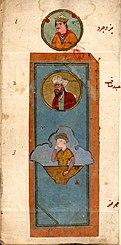Abd Manaf al-Mughirah ibn Qusai عبد مناف ٱلمغيرة ٱبن قصي | |
|---|---|
 Calligraphy illustrating Name of Abd Manaf of the Quraysh tribe | |
| 2nd Major Chief Leader of Quraysh | |
| Preceded by | Qusai ibn Kilab |
| Succeeded by | Hashim ibn Abd Manaf |
| Personal details | |
| Born | Makkah, Hijaz |
| Spouse(s) | Atikah bint Murrah al-Hulaliyya Rayta bint Ku'ayb al-Thaqafiyya Waqidah bint Amr al-Qurayshiyya al-Amiriyya |
| Children | Nawfal ibn Abd Manaf (son) Hashim ibn 'Abd Manaf (son) Muttalib ibn Abd Manaf (son) Tumadir bint Abd Manaf al-Quraishiyya |
| Parents | Qusai ibn Kilab (father) |
| Relatives | Abd-al-Dar ibn Qusai (brother) Zuhrah ibn Kilab (uncle) |
| Known for | Ancestor of Prophet Muhammad |
Abd Manaf al-Mughirah ibn Qusai (Arabic: عبد مناف ٱلمغيرة ٱبن قصي, Abd Manāf al-Mughīrah ibn Quṣayy) was a Qurayshi and great-great-grandfather of Islamic prophet Muhammad. His father was Quṣai ibn Kilāb.
Biography
Abd Manaf was already honoured in his father's lifetime however Qusai preferred his first-born 'Abd ad-Dar and invested him with all his rights, powers, and transferred the ownership of the House of Assembly shortly before his death.[1]
Father's death
After Quṣayy's death, Abd Manaf contested this inheritance. He was supported by their nephew Asad, their uncle Zuhrah ibn Kilab, their father's uncle Taym ibn Murrah (of Banu Taym), and al-Harith ibn Fihr, while 'Abd ad-Dar was supported by their cousins Makhzum, Sahm, Jumah, their uncle Adi and their families. The effects of this conflict continued among their descendants, especially under Abd Manaf's son Hashim and affected the internal history of Mecca right up to Muhammad's time.[2]
Family
Abdu Manaf married several wives of influential tribes, including 'Ātikah bint Murrah ibn Hilāl ibn Fālij ibn Dhakwān ibn Hilal ibn Sa'sa'ah ibn Mu'awiyah ibn Bakr ibn Hawazin al-Hilaliyya of Bani Qays Aylan, Hilal of the Banu Bakr ibn Hawāzin, Raytah of Ta'if, and Waqida bint Amr.
Origin of tribes of Quraysh
Abd Manaf had three wives:
1. Atikah bint Murrah al-Hulaliyya
- a. Muttalib ibn Abd Manaf, Founder/ancestor of Banu Muttalib
- b. Amr-al-Ula/Hashim ibn Abd Manaf, Founder/ancestor of Banu Hashim
- c. Abd Shams/Qays-al-Ula ibn Abd Manaf, Founder/ancestor of Banu Abd Shams
- d. Tumadir bint Abd Manaf al-Quraishiyya
- e. Qilabah bint Abd Manaf al-Quraishiyya
- f. Hayyah bint Abd Manaf al-Quraishiyya
- g. Rayta bint Abd Manaf al-Quraishiyya
- h. Khathma bint Abd Manaf al-Quraishiyya
- i. Sufyanah bint Abd Manaf al-Quraishiyya
2. Rayta bint Ku'ayb al-Thaqafiyya
- a. Abd ibn Abd Manaf
- b. Abd-al-Amr ibn Abd Manaf
3. Waqidah bint Amr al-Qurayshiyya al-Amiriyya
- Nawfal ibn Abd Manaf, Founder/ancestor of Banu Nawfal
Death and burial
The grave of Abd Manaf can be found in Jannatul Mualla cemetery, in Mecca.
Notable descendants
| Quraysh tribe (detailed tree) | |||||||||||||||||||||||||||||||||||||||||||||||||||||||||||||||||||||||||||||||||||||||||||||||||||||
| Waqida bint Amr | Abd Manaf ibn Qusai | Ātikah bint Murrah | |||||||||||||||||||||||||||||||||||||||||||||||||||||||||||||||||||||||||||||||||||||||||||||||||||
| Nawfal ibn Abd Manaf | ‘Abd Shams | Barra | Hala | Muṭṭalib ibn Abd Manaf | Hashim | Salma bint Amr | |||||||||||||||||||||||||||||||||||||||||||||||||||||||||||||||||||||||||||||||||||||||||||||||
| Umayya ibn Abd Shams | ʿAbd al-Muṭṭalib | ||||||||||||||||||||||||||||||||||||||||||||||||||||||||||||||||||||||||||||||||||||||||||||||||||||
| Harb | Abū al-ʿĀs | ʿĀminah | ʿAbdallāh | Hamza | Abī Ṭālib | Az-Zubayr | al-ʿAbbās | Abū Lahab | |||||||||||||||||||||||||||||||||||||||||||||||||||||||||||||||||||||||||||||||||||||||||||||
| ʾAbī Sufyān ibn Harb | al-Ḥakam | ʿUthmān | ʿAffān | MUHAMMAD (Family tree) | Khadija bint Khuwaylid | ʿAlī (Family tree) | Khawlah bint Ja'far | ʿAbd Allāh | |||||||||||||||||||||||||||||||||||||||||||||||||||||||||||||||||||||||||||||||||||||||||||||
| Muʿāwiyah I | Marwān I | ʿUthmān ibn ʿAffān | Ruqayyah | Fatimah | Muhammad ibn al-Hanafiyyah | ʿAli ibn ʿAbdallāh | |||||||||||||||||||||||||||||||||||||||||||||||||||||||||||||||||||||||||||||||||||||||||||||||
| Sufyanids | Marwanids | al-Ḥasan | al-Ḥusayn (Family tree) | Abu Hashim (Imām of al-Mukhtār and Hashimiyya) | Muhammad "al-Imām" (Abbasids) | ||||||||||||||||||||||||||||||||||||||||||||||||||||||||||||||||||||||||||||||||||||||||||||||||
| Ibrāhim "al-Imām" | al-Saffāḥ | al-Mansur | |||||||||||||||||||||||||||||||||||||||||||||||||||||||||||||||||||||||||||||||||||||||||||||||||||
See also
- Abd Manaf (name)
- Family tree of Muhammad
- List of notable Hijazis
